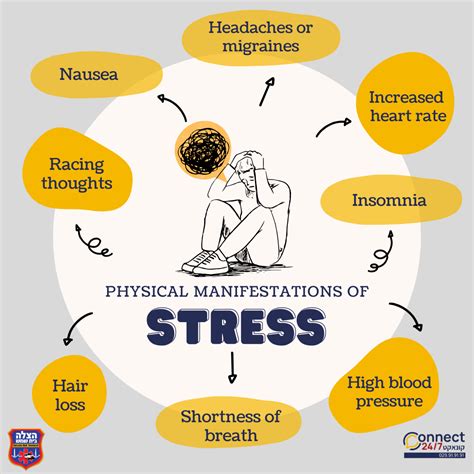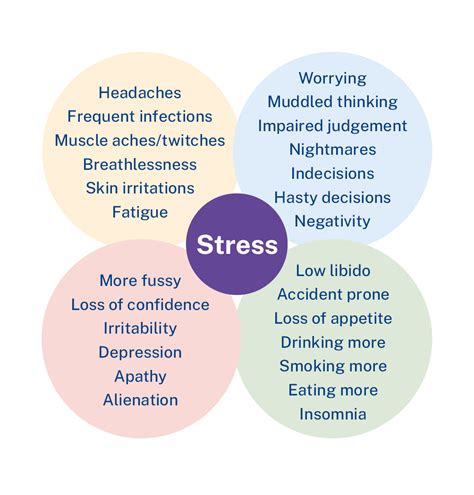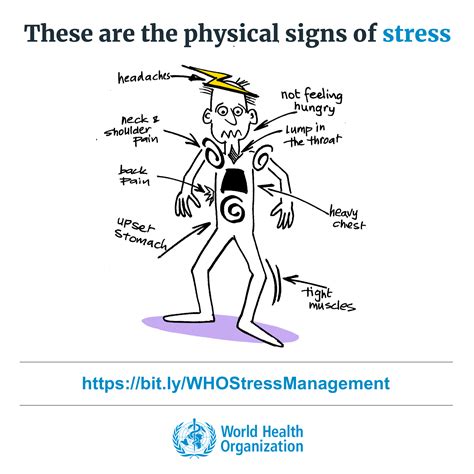Intro
Learn to identify physical signs of stress, including anxiety symptoms, tension headaches, and fatigue, to manage stress effectively and improve overall well-being through stress relief techniques.
Stress is a common experience that can affect anyone, regardless of their background or circumstances. It is a natural response to a perceived threat or pressure, and it can manifest in different ways, including physically, emotionally, and behaviorally. While stress can be beneficial in small doses, chronic stress can have negative consequences on our overall health and well-being. Therefore, it is essential to recognize the physical signs of stress to take proactive steps to manage it.
The physical signs of stress can vary from person to person, but there are some common symptoms that many people experience. These symptoms can range from mild to severe and can affect different parts of the body. For instance, some people may experience headaches, muscle tension, or digestive problems when they are stressed, while others may experience sleep disturbances, fatigue, or changes in appetite. Recognizing these physical signs of stress is crucial in taking care of our overall health and preventing long-term damage.
Understanding the physical signs of stress is also important in maintaining productivity and performance in our daily lives. When we are stressed, our bodies undergo a series of physiological changes that can affect our ability to focus, think clearly, and make sound decisions. Chronic stress can also lead to burnout, which can result in decreased motivation, reduced creativity, and poor work performance. By recognizing the physical signs of stress, we can take steps to manage our stress levels, improve our overall well-being, and maintain our productivity and performance.
Common Physical Signs Of Stress

The physical signs of stress can be categorized into different groups, including cardiovascular, musculoskeletal, gastrointestinal, and immune system symptoms. Some common physical signs of stress include:
- Headaches and migraines
- Muscle tension and pain
- Fatigue and exhaustion
- Sleep disturbances and insomnia
- Digestive problems and irritable bowel syndrome
- Weight gain or loss
- Skin problems and acne
- Hair loss and brittle nails These physical signs of stress can be caused by the release of stress hormones, such as cortisol and adrenaline, which prepare our bodies for the "fight or flight" response. While these hormones can be beneficial in emergency situations, chronic stress can lead to an overproduction of these hormones, resulting in negative consequences on our physical health.
Cardiovascular Symptoms
Cardiovascular symptoms are common physical signs of stress that can affect the heart and blood vessels. These symptoms can include: * High blood pressure * Rapid heartbeat and palpitations * Chest pain and tightness * Shortness of breath and difficulty breathing These symptoms can be caused by the increased heart rate and blood pressure that occur during the "fight or flight" response. Chronic stress can lead to cardiovascular disease, including heart attacks, strokes, and high blood pressure.Causes Of Physical Signs Of Stress

The physical signs of stress can be caused by a variety of factors, including:
- Work-related stress
- Financial stress
- Relationship problems
- Health issues
- Trauma and abuse
- Major life changes These factors can trigger the release of stress hormones, leading to physical symptoms such as headaches, muscle tension, and digestive problems. Understanding the causes of physical signs of stress is essential in developing effective coping strategies and managing stress levels.
Managing Physical Signs Of Stress
Managing physical signs of stress requires a comprehensive approach that includes lifestyle changes, stress management techniques, and professional help when needed. Some effective ways to manage physical signs of stress include: * Exercise and physical activity * Meditation and mindfulness * Deep breathing and relaxation techniques * Time management and prioritization * Social support and networking * Healthy eating and nutrition * Sleep hygiene and stress managementBenefits Of Managing Physical Signs Of Stress

Managing physical signs of stress can have numerous benefits, including:
- Improved physical health and well-being
- Enhanced mental health and resilience
- Increased productivity and performance
- Better relationships and social connections
- Improved overall quality of life By recognizing the physical signs of stress and taking proactive steps to manage them, we can reduce the negative consequences of stress and improve our overall health and well-being.
Strategies For Managing Physical Signs Of Stress
There are several strategies that can help manage physical signs of stress, including: * Identifying and challenging negative thoughts and beliefs * Practicing self-care and self-compassion * Setting realistic goals and priorities * Building a support network and social connections * Engaging in regular exercise and physical activity * Getting enough sleep and practicing stress management techniquesConclusion And Next Steps

In conclusion, recognizing physical signs of stress is essential in taking care of our overall health and well-being. By understanding the common physical signs of stress, causes, and management strategies, we can take proactive steps to reduce stress levels and improve our quality of life. If you are experiencing physical signs of stress, consider seeking professional help from a healthcare provider or a mental health specialist. They can help you develop a personalized plan to manage stress and improve your overall health and well-being.
Final Thoughts
Managing physical signs of stress requires a comprehensive approach that includes lifestyle changes, stress management techniques, and professional help when needed. By prioritizing our health and well-being, we can reduce the negative consequences of stress and improve our overall quality of life. Remember, recognizing physical signs of stress is the first step towards taking control of our health and well-being.What are the common physical signs of stress?
+The common physical signs of stress include headaches, muscle tension, fatigue, sleep disturbances, digestive problems, and weight gain or loss.
How can I manage physical signs of stress?
+Managing physical signs of stress requires a comprehensive approach that includes lifestyle changes, stress management techniques, and professional help when needed. Some effective ways to manage physical signs of stress include exercise, meditation, deep breathing, time management, and social support.
What are the benefits of managing physical signs of stress?
+Managing physical signs of stress can have numerous benefits, including improved physical health and well-being, enhanced mental health and resilience, increased productivity and performance, and better relationships and social connections.
We hope this article has provided you with valuable insights into recognizing physical signs of stress and managing them effectively. If you have any questions or comments, please feel free to share them below. You can also share this article with your friends and family to help them manage stress and improve their overall health and well-being. Remember, taking care of our physical and mental health is essential in maintaining our overall quality of life.
